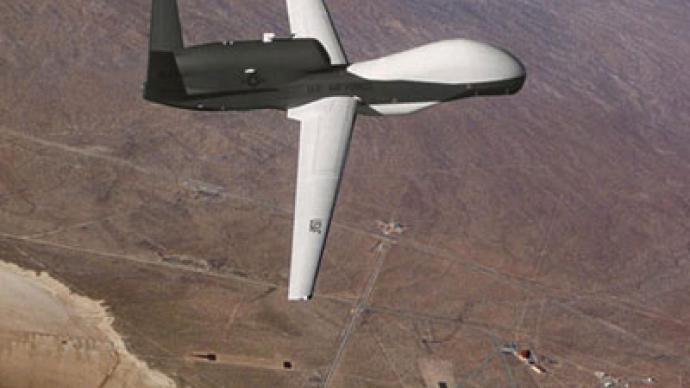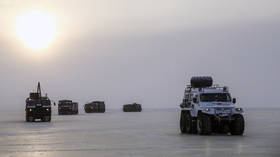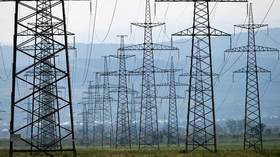Drones cleared for domestic use across the US

What do you know about drones? You know drones — those robotic, unmanned planes that fire missiles for the American military across Afghanistan, Pakistan and anywhere else the United States needs to get away with murder.
Well if you don’t know too much, don’t worry, that’ll change soon. The Federal Aviation Administration is looking into rules that will bring the controversial aircraft into the country, creating an United States airspace buzzing with tiny, robot planes to look over every inch of American soil — and maybe more.An article published Tuesday in the Los Angeles Times reveals that new drone planes could be coming domestically quite soon, as both law enforcement and the agricultural sector are seeing benefits in keeping an arsenal of unmanned planes ready to patrol the skies. For farmers, drones could bring a new method of pumping pesticides into fields of crops from above; for the cops, the aircraft could conduct surveillance over suspected criminals (think police chopper but remote controlled). The Times reports that utility companies see a benefit in drones as well, giving them a new set of eyes to monitor oil, gas and water pipelines.But with missile-equipped drones causing thousands of deaths overseas, the installation of a drone program stateside could be detrimental to America as the government all but deems the country fit as a warfront."It's going to happen," Dan Elwell, vice president of civil aviation at the Aerospace Industries Association, tells the Times. "Now it's about figuring out how to safely assimilate the technology into national airspace."According to the Department of Homeland Security’s website, the government has already been using drones domestically for several years, but remains mostly mum on their missions, other than that they are regularly used for "support of disaster relief efforts."In July, however, retired Air Force Maj. Gen. Michael Kostelnik, currently with the US Customs and Border Protection UAV program, told a congressional subcommittee that a third drone was being added to an arsenal of two that already fly over Texas to patrol the US/Mexico Border.“On any given day there could be three or more (unmanned) aircraft in Texas,” said Kostelnik.As the FAA investigates legislation to govern drones domestically for a variety of reasons, the US Air Force says that it will train more drone pilots than fighter and bomber pilots combined, reports National Public Radio. Though the military has not explicitly stated that they intend on flying Predator drones — the kind equipped with Hellfire missiles — through American airspace, it will soon have the manpower to up their robot game. Strangely enough, the US Senate is currently considering a provision to the National Defense Authorization Act which would make America a battlefield of itself, which RT reported on Monday. Earlier this year, RT also revealed that the military is investing $23 billion into new drone crafts, and that the US has added bases to fly the planes in and out of across the world. A friendly fire strike gone disastrous in April killed two American troops mistaken as Taliban insurgents, and a September strike in Yemen killed two American citizens alleged to have ties to al-Qaeda. Following that strike, Republican Congressman Ron Paul told an audience during a televised GOP debate that “now we know American citizens are vulnerable to assassination.” A passing of the National Defense Authorization Act’s latest provision this week, coupled with a reinforced drone arsenal, could create such executions to be carried out stateside, by-the-books.So far the FAA has issued 266 testing permits to allow for civilian drones in the United States, but the Times reports that the aircraft aren’t flying in large numbers yet, as the agency says that the crafts do not have the proper technology to keep them from crashing into each other as they start to soar in growing numbers. Small drones are being manufactured in the thousands, however, and AeroVironment Inc. has created a drone helicopter for police monitoring and intends on sending 18,000 of them to law enforcement agencies once the crafts have clearance. Those drones, reports the Times, weigh barely five pounds and could be controlled by a tablet computer."This is a tool that many law enforcement agencies never imagined they could have,” Steven Gitlin of the aerospace company tells the Times. As the realm of drone-filled skies becomes a reality, Americans could be experiencing a police state that they never could have imagined, either. AeroVironment’s planes are being manufactured particularly for law enforcement purposes and could create an eye-in-the-sky small enough to fit in the trunk of a car that'd monitor every action from high in the air — undetectable to the naked eye yet all knowing of every move."By definition, small drones are easy to conceal and fly without getting a lot of attention," John Villasenor, a UCLA professor and senior fellow at the Brookings Institution's Center for Technology Innovation, adds to the Times.Also getting less attention are the programs used to create the crafts itself. A recent report in Wired.com’s Danger Room reveals that the US military has been keeping members of the press off of drone bases in increasing numbers as of late, keeping the progress of the program overseas highly unreported. “The change in guidance wasn’t a light switch that turned off all public access to information about [remotely piloted aircraft],” Lt. Col. Tadd Sholtis, spokesman at Air Combat Command, tells Danger Room. “It was a recognition of the sensitive nature of the mission and the risks involved in unrestricted media access to an operational unit.”The US government has repeatedly dismissed claims that put drone attacks in alarming numbers contrary to their own count, responsible for a shocking toll of deaths; though reporting overseas has unearthed figures that would frighten most people living under skies patrolled by drones. According to a report this year from Britain’s Bureau of Investigative Journalism, US drone strikes have killed nearly 400 civilians in Pakistan alone, and that the CIA has launched 291 attacks by the report’s publishing in August — eight percent more than the Central Intelligence Agency had admitted to. Casualties in all, adds the UK’s Bureau, are at least 40 percent higher than what the US has reported. Standing up for his research, Bureau Editor Iain Overton tells CNN that "All of our sources are credible and transparent, and where contradictory information exists, we make that clear.”"It is unfortunate that instead of engaging with our work, the CIA sees fit to smear it,” adds Overton.Pentagon spokesperson George Little reported to the press this October that the US launched nearly 150 airstrikes with drones over Libya in just the few months of NATO involvement in the oust of Muammar Gaddafi. With drones coming to a sky near you — and your neighborhood soon being considered a battlefield — the number of strikes could increase and come a little too close to home. Literally."Most Americans still see drone aircraft in the realm of science fiction," author Peter W. Singer tells the Times. "But the technology is here. And it isn't going away. It will increasingly play a role in our lives. The real question is: How do we deal with it?"With lawmakers pushing for drones to dominate our skies, American civilians aren’t left with many options to deal with it than just that — deal with it. Both sides of the aisle have shown support for drones.GOP presidential hopeful Jon Huntsman said earlier this month that “an expanded drone program is something that would serve our national interests” and that it “must be done.” The Bureau of Investigative Journalism report earlier this year calculated that President Obama has been in office for around 236 drone strikes against Pakistan — or one for every four days in office. Foreign policy aside, politicians have shown support for bringing drones to America. Now that the FAA has given it the go ahead, it is only a matter of time before the robotic whizzing of robotic crafts being a regular occurrence. “We know that there are Predator drones being flown for practice every day because we're seeing them; we're preparing these young people to fly missions in these war zones that we have,” Texas Governor Rick Perry said in New Hampshire earlier this year. “But some of those, they have all the equipment, they're obviously unarmed, they've got the downward-looking radar, they've got the ability to do night work and through clouds.”“Why not be flying those missions and using (that) real-time information to help our law enforcement?” asked Perry.Last year the Obama administration got behind a $600 million border security bill that will bring two more drones to the US/Mexico border. Congress approved it in 2010. By this summer, the Customs and Border Protection had six drones in their arsenal to monitor their border. For those not in Texas, Arizona or anywhere near the southwest US, however, you could expect to see those numbers increase. Be sure to wave if you see them, too. “You have a lot of police chiefs and sheriffs that would love to have this information,” Rep. Henry Cuellar, D-Laredo, said of the technology earlier this year. “Technology is part of the long-term solution to securing the border,” Rep. Michael McCaul, R-Austin, said in a letter to Congress earlier this year. Say good-bye to long-term. Drones are here and they are only going to get smaller, stealthier and greater in numbers.Smile, you’re on drone-craft camera.















